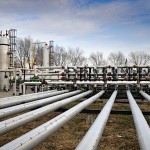Natural gas futures declined to the weakest level in more than seven weeks, after a government report showed yesterday that US gas stockpiles fell less than projected last week and as weather forecasting models called for a springlike weather across many densely populated US areas, curbing demand for the power-station fuel.
On the New York Mercantile Exchange (NYMEX), natural gas for delivery in April $4.342 per million British thermal units, the weakest level since January 21,after which it pared losses to trade at 4.397 by 12:31 GMT, adding 0.34% for the day. Day’s high was touched at $4.399 per mBtu.
Natural gas added 0.15% last week, after losing 26% in the previous 5-day period, the biggest weekly drop since December 1996. In 2013, the energy source added 26%, the best performance since 2005 and second straight annual advance.
EIA’s weekly US gas storage report
The Energy Information Administration reported yesterday that US natural gas inventories fell by 195 billion cubic feet in the seven days through March 7th, less than the median analyst’ forecast of a 199 billion cubic feet drop and compared to a withdrawal of 145 billion cubic feet the same week a year ago. However, the decline was more than double the five-year average drop of 95 bcf during the comparable period.
“The market thought the storage withdrawal was going to be stronger than that,” said Gordy Elliott, a risk-management specialist at Intl FC Stone LLC in St. Louis Park, Minnesota, cited by Bloomberg. “Spring is coming and the weather maps look warmer, so there’s downside risk from here.”
Total gas held in US underground storage hubs fell to a 10-year seasonal low of 1.001 trillion cubic feet. US gas stockpiles were 48.9% below last year’s amount of 1.959 trillion cubic feet during the comparable week. The deficit to the five-year average widened to a record 46.2%, up from 38.8% a week earlier.
Inventories at the East Region received a net withdrawal of 95 bcf and fell to 430 bcf, 47.9% below the five-year average of 825 billion cubic feet. Stockpiles in the West Region fell by 21 bcf to 169 bcf and were 42.9% beneath the average. Inventories at the Producing Region slid by 79 bcf. At 402 bcf, they were 45.5% below the five-year average amount of 737 billion cubic feet.
Short-term weather outlook
NatGasWeather.com reported on March 14th that another quiet day is expected in the US, as many regions rebound from the recent cold outbreak. Temperatures will warm into the 50s and 60s across much of the Midwest and Northeast into Saturday, before a reinforcing cold blast follows this weekend over the northern US, with areas of light snow showers.
A fresh weather system is expected to develop over the south-central US also over the weekend and may lead to wintry mess over the southern Ohio Valley and into the Mid-Atlantic. Another warm-up will follow early next week, before the next cold blast, is expected to track across the northern US and to hold into the following weekend.
According to AccuWeather.com, the low in Cleveland on March 25th may hit 44 degrees Fahrenheit, 10 above average, while readings in Detroit may bottom at 42 degrees Fahrenheit, above the average of 32. The low in Boston is expected to be 40 degrees Fahrenheit, 6 degrees above normal.
Extended forecast
NatGasWeather.com’s extended forecast for the period March 21st-27th called for a very sloppy pattern to mark the outlook period, with various scenarios that can play out. There are two contrary scenarios, the first one calls for a very cold air over southern Canada, but not much over the northern US, while the other forecast the cold air to push fairly deep into the central US. The latter will lead to wildly varying national forecasts, according to the website, as models struggle to determine how this will play out.
Nevertheless, NatGasWeather.com reported that there will be warm surges, strong storms and cold blasts, with the only question remaining how much warmer and colder. Milder conditions will probably occur around March 22nd-25th, followed by more impressive cold blasts for the northern US thereafter.




